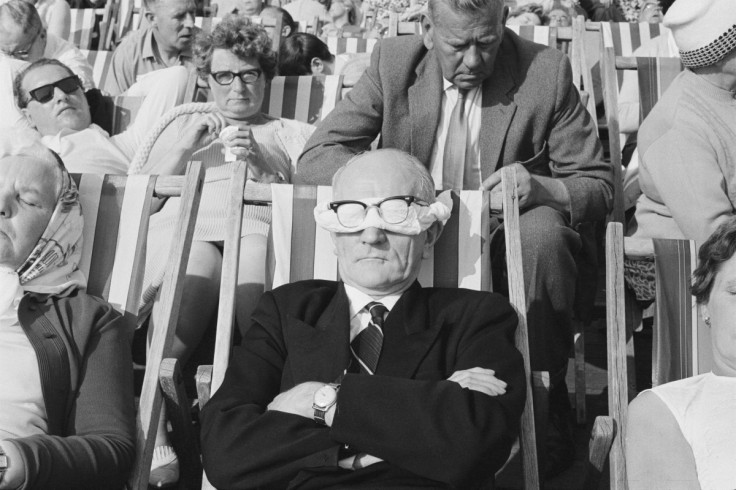Science Museum Photography Exhibition Review: Only in England by Martin Parr and Tony Ray-Jones

This was my first visit to the Science Museum after all these years in London and I was overwhelmed and inundated with myriad of kids.
Fortunately though, the exhibition I wanted to see was tucked away on the second floor, a refuge from the young crowd. The new Media Space, made possible by the generous support of the Dana and Albert R Broccoli Foundation (the family of the James Bond producer), Virgin Media and M. and J. Wilson is a new photography art gallery in the Science Museum.
Carefully organised and architecturally partitioned, the exhibition Only in England explores the relationship of two British photographers Tony Ray-Jones (1941-72) and Martin Parr (1952) and their fascination with English life.
The exhibition is nostalgic and takes us back in time.
For this show, British photographer, curator, collector and book producer (he has produced 50 books of his photographs) Parr was invited to select previously unpublished and unseen photographs from a selection of Ray-Jones' 2700 contact sheets of English themes.
Parr reveals, "in my photography career there has been many landmarks moments and revelations, but perhaps the most influential moment was seeing the work of British photographer Ray-Jones".
Parr's Non-Conformists (1975-79) photographs were influenced and inspired by Ray-Jones' book 'Day Off' that Parr bought at the age of 22. Parr admires Ray-Jones' iconic images with their quirky English observations and eccentricities.
The exhibition offers a rare opportunity to view over 55 previously unseen black and white vintage silver-gelatin photographs by Ray-Jones alongside early 1970s Martin Parr's prints.
Despite his tragic premature death at the age of 30, Ray-Jones' prolific career is evident just by looking at his complex, multi-layered black and white, witty and theatrical photographs, his extensive few thousands contact sheets, his manifesto, notes and ideas on photography.
Tony Ray-Jones
Ray- Jones died from Leukemia at a very young age of 30, in 1972. His main work was a record of the English at leisure.
In 1962, he worked in New York City, where he attended the design lab run by the influential art director of Harper's Bazaar; Alex Brodovitch.
This is where he learned to treat the everyday as a form of theatre. Wandering the streets of New Haven, the English countryside and beach places, he took sophisticated humorous and witty narrative of English manners and customs.
A mixture of wry humour and melancholy, Ray-Jones approached his subject matters like an anthropologist. He was interested in the eccentricities of human behaviour.
He captured carnivals, parades, dog shows, markets, boarding houses, Chelsea flower shows, Brick Lane markets, horse shows, Schools, Colleges.
Ray-Jones' humour is also clear in his notes about the characteristics of the English stoic holidaymakers braving bad weather while drinking tea.
In the revealing video showed at the gallery, Parr explains how Ray-Jones treated photography as a form of theatre something that he learned in America. Inspired by the New York group of photographers such as Garry Winogrand, Joel Meyerowitz and their ability to use the street, as the backdrop to seek out dramas was key to the language of Ray-Jones.
He used this personal dramas formula in England and England was for the first time photographed this way. At the time, Street photography was a tradition in America and was used by Ray-Jones to record English manners perceived at the beach, seasons, festivals and in the countryside.
His strength to construct dramas and layered, complex images was what most appealed to Parr and personally to me.
The public can also view Ray-Jones' notes displayed in a cabinet "talk to people, be patient, stay with the subject matter, be more aware of perspective, don't shoot too much, no middle distance, don't take boring pictures".
Martin Parr
Parr's work shares the wry humour and wistfulness of Ray-Jones but is distinct in its formality and spatial perspective using a bigger and brighter format.
Parr said, "With photography, I like to create fiction out of reality. I try and do this by taking society's natural prejudices and giving them a twist".
Over his 40-year career, Parr is considered a chronicler of our age. Since 1994, Parr has been a member of Magnum Photos.
He has had almost 50 books published, and featured in around 80 exhibitions worldwide - including an exhibition at the Barbican Arts Centre, London.
In 2007, his retrospective exhibition was selected to be the main show of Month of Photography Asia in Singapore. In 2008, he was made an Honorary Doctor of Arts at Manchester Metropolitan University (MMU) in recognition for his ongoing contribution to photography and to MMU's School of Art.
An internationally renowned photographer, filmmaker, collector and curator, he is also well known for his highly saturated colour photographs critiquing modern life.
For this exhibition, Parr's series, The Non- Conformists depicts his fascination with criticism, and humour of the variety of chapels and the communities he encountered in different towns in England.
Comparing the two photographers, Ray-Jones' photos are more layered, observed, mysterious, atmospheric, theatrical, funny and manage to transport us into a different era.
His technique of dramatization and pushing the subject to the edge of the frame to establish a tension is intriguing and inspirational. Martin Parr's photos are bigger, brighter, clearer with a broader spatial field and have a more obvious and optimistic touch.
It feels like Ray- Jones short but prolific career made a lasting influence on the development of British photography from the 1970s through to the present and today Martin Parr is the successor.
Leaving the museum, the sky was grey and I remembered what Ray-Jones said, "When I got back to England I found everything so grey that I didn't see the point of shooting in colour. To me, Britain is very much a black-and-white country."
Virginia Damtsa is the co-founder of contemporary art gallery Riflemaker with Tot Taylor.
© Copyright IBTimes 2025. All rights reserved.





















